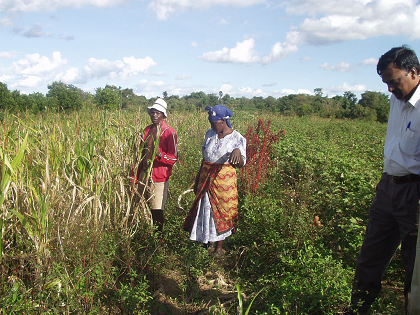
Farmers near Masii, Kenya, discuss their use of crop diversification for managing risk with ICRISAT scientist K.P.C. Rao. Photo: J. Hansen (CCAFS)
GENEVA, 16 October 2017 - “World hunger is on the rise and the estimated number of undernourished people has increased from 777 million in 2015 to 815 million in 2016”, according to Ms. Carolyn Rodrigues Birkett Director, Food and Agriculture Organization (FAO) - Liaison Office in Geneva.
Opening a panel discussion on Integrating Climate Change Adaptation and Disaster Risk Reduction in the Agriculture Sectors on Friday for the 2017 International Day for Disaster Reduction, Ms. Birkett said, “In developing countries the agriculture sector absorbs about 22% of the total damage and losses caused by natural hazards. And, if one just considers drought, this figure rises to 84%. No sector is more sensitive than agriculture and no solution to climate change and disasters will be complete without agricultural inputs.”
Ms. Shoko Arakaki, Chief, Regional Programme Coordination and National Implementation Support, UN Office for Disaster Risk Reduction said the yearly average loss from disasters in low income countries was now between 20-60% of their annual social expenditure.
“If not addressed, these losses will escalate exponentially, driven primarily by risk-blind economic growth in the public and private sectors, by the frequency and intensity of disasters, and by the cascading impacts of catastrophes.” She said there was a critical need to embed risk in core development planning. “This will require a better understanding of disaster risk through disaster loss data from the past, and, from risk models and profiles for the future. Climate and disaster risk have to be considered together.”
Ms. Sophie Baranes, Coordinator, Capacity for Disaster Reduction Initiative, said there was no integration between the climate change and disaster risk reduction communities. “There is fragmentation between these two and they are often run by two different ministries. Our biggest challenge is integration. A focus on one sector only is doomed to failure – there must be coordination and synergy.”